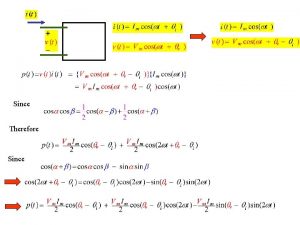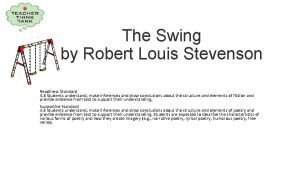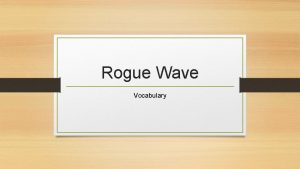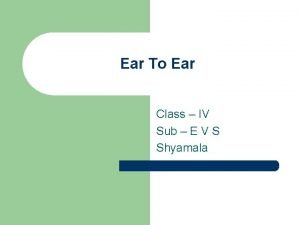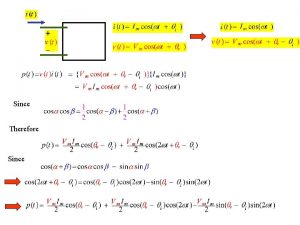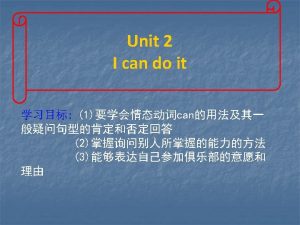Since Therefore Since You can see that the































































- Slides: 63

Since Therefore Since

You can see that the frequency of the Instantaneous power is twice the frequency of the voltage or current

The instantaneous power real (or average) power (Watts) Which is the actual power absorb by the element Examples Electric Heater , Electric Stove , oven Toasters, Iron …etc reactive power Which is the reactive power absorb or deliver by the element Reactive power represents energy stored in reactive elements (inductors and capacitors). Its unit is Volt Ampere Reactive (VAR)

The instantaneous power real (or average) power (Watts) reactive power (Volt Ampere Reactive (VAR) )

Complex Power Previously, we found it convenient to introduce sinusoidal voltage and current in terms of the complex number the phasor Definition Let the complex power be the complex sum of real power and reactive power

Advantages of using complex power - We can compute the average and reactive power from the complex power S - complex power provide a geometric interpretation were The geometric relations for a right triangle mean the four power triangle dimensions ( , P, Q, ) can be determined if any two of the four are known

Power Calculations were Is the conjugate of the current phasor Circuit Since Similarly

Power Calculations Summery Circuit

In any circuit, conservation of complex power is achieved This implies that in any circuit, conservation of average power and Conservation of reactive power are achieved However, the apparent power (the magnitude of the complex power) is not conserved

Ex: 6. 13 Determine the average and reactive power delivered by the source. The phasor current leaving the source is The average power delivered by the source is:

The reactive power delivered by the source is: And the complex power delivered by the source is

Determine the average power and reactive power delivered to each element The voltage across the elements are: Thus the complex power delivered to each element is

show that conservation of complex power, average power, and reactive power is achieved.

6. 6. 1 Power Relations for the Resistor The voltage and current are in phase so Average power is: Reactive power is zero for resistor

6. 6. 1 Power Relations for the Inductor The voltage leads the current by 90 so that

6. 6. 1 Power Relations for the Capacitor The current leads the voltage by 90 so that

The power factor Recall the Instantaneous power p(t) The angle v - i plays a role in the computation of both average and reactive power The angle v - i is referred to as the power factor angle We now define the following : The power factor

The power factor Knowing the power factor pf does not tell you the power factor angle , because To completely describe this angle, we use the descriptive phrases lagging power factor and leading power factor Lagging power factor implies that current lags voltage hence an inductive load Leading power factor implies that current leads voltage hence a capacitive load

6. 6. 2 Power Factor Since

Circuit

Circuit

EX: 6. 15 Determine the average and reactive powers delivered to the load impedance and the power factor of the load Average power

Average power

reactive powers

reactive powers OR

EX: 6. 15 Determine the average and reactive powers delivered to the load impedance and the power factor of the load OR

This could also be calculated from the complex power delivered to the load The power factor of the load is: The load is lagging because the current lags the voltage

A typical power distribution circuit The consumer is charged for the average power consumed by the load The load requires a certain total apparent power

Ex 6. 16 Suppose that the load voltage figure is 170 V The line resistance is 0. 1 ohm The load requires 10 KW of average power. Examine the line losses for a load power factor of unity and for a power factor of 0. 7 lagging. The load current is obtained from For unity power factor this is For power factor of 0. 7 The powers consumed in the line losses 720 W extra power to be generated if pf is 0. 7 to supply the load

Power Factor Correction Ex: 6. 17: in Ex 6. 16 determine the value of capacitor across the load to correct the power factor from 0. 7 to unity if power frequency is 60 Hz. From Ex 6. 16 For power factor of 0. 7 power factor 0. 7 lagging The current through the added capacitor is: Hence the total current Unity power factor Imaginary component of the line current is zero


The average power delivered to the load is:

6. 6. 3 Maximum Power Transfer Source-load Configuration Determine the load impedance so that maximum average power is delivered to that load. Represent the source and the load impedances with real and imaginary parts: The load current is:

The average power delivered to the load is: Since the reactance can be negative and to max value, we choose leaving Differentiate with respect to RL and set to zero to determine required RL which is RL = R S Hence: In this case the load is matched to the source. The max power delivered to the load becomes:

6. 6. 4 Superposition of Average Power Average power computation when circuit contains more than one source


The instantaneous power delivered to the element is Substituting Using the identity

Using the identity

Average powers delivered individually by the sources Suppose that the two frequencies are integer multiples of some frequency as The instantaneous power becomes

Averaging the instantaneous over the common period THUS: we may superimpose the average powers delivered by sources of different frequencies, but we may not, in general, apply superposition to average power if the sources are of the same frequency. where

Ex 6. 18: Determine the average power delivered by the two sources of the circuit Hence the average power delivered by the voltage source is This can be confirmed from average powers delivered to the two resistors

By current division: The voltage across the current source is Hence the average power delivered by the current source is This may be again confirmed by computing the average power delivered to the Two resistors: Since frequencies are not the same, total average power delivered is the sum of average powers delivered individually by each source

EX 6. 19: Determine the average power delivered by the two sources Since both sources have the same frequency, we can’t use superposition. So we include both sources in one phasor circuit. The total average power delivered by the sources is equal to the average power delivered to the resistor We use superposition on the phasor circuit to find the current across the resistor

The phasor current is: Hence the average power delivered to the resistor is Note that we may not superimpose average powers delivered to the resistors by the individual sources We can compute this total average power by directly computing the average power delivered by the sources from the phasor circuit The voltage across the current source is The average power delivered by voltage source is The average power delivered by the current source is The total average power delivered by the sources is

6. 6. 5 Effective (RMS) Values of Periodic Waveforms Sinusoidal waveform is one of more general periodic waveforms Apply a periodic current source with period T on resistor R The instantaneous power delivered to the resistor is The average power delivered to the resistor is Hence the average power delivered to the resistor by this periodic waveform can be viewed as equivalent to that produced by a DC waveform whose value is This is called the effective value of the waveform or the root-mean-square RMS value of the waveform

Ex 6. 20 Determine the RMS value of the current waveform and the average power this would deliver to resistor The RMS value of the waveform is Hence the average power delivered to the resistor is

RMS voltages and currents in phasor circuits The sinusoid has a RMS value of Hence the average power delivered to a resistor by a sinusoidal voltage or current waveform is In general, the average power delivered to an element is Therefore, if sinusoidal voltages and currents are specified in their RMS values rather than their peak values, the factor ½ is removed from all average-power expressions. However, the time-domain expressions require a magnitude multiplied by square root of 2 Since X is the peak value of the waveform. Common household voltage are specified as 120 V. This is the RMS value of the peak of 170 V.

Ex 6. 21 Determine the average power delivered by the source and the time-domain current i(t) Phasor circuit with rms rather than peak The phasor current is Hence the average power delivered by the source is The time-domain current is

Commercial Power Distribution

Time domain representation




Using Vectors




6. 9. 1 Wye-Connected Loads We are going to investigate the transmission of power from three phase generator to two types of load: I – WYE connected load Hence the current returning through the neutral wire is zero, and the neutral may be removed

Power calculation For a balanced wye-connected load, the voltages across the individual loads are the respective phase voltages whether the neutral is connected or not. The power delivered to the individual loads is three times the power delivered to an individual load, because the individual loads are identical. No ½ factor in power expression because values are rms

Since the line voltage is more accessible than the phase voltage Power in terms of line-to-line voltages and load current gives

Example 6. 24 Consider a balanced, wye-connected load where each load impedance is the phase voltages are 120 V. Determine the total average power delivered to the load. The line currents are Hence, the average power delivered to each load is The total average power delivered to the load is

Example 6. 25 If the line voltage of a balanced, wye-connected load is 208 V and the total average power delivered to the load is 900 W, determine each load if their power factors are 0. 8 leading. Thus The phase voltage is Thus the magnitude of the individual load impedance is Since the power factor is 0. 8 leading (current leads voltage; voltage lags current) Thus the individual loads are

Example 6. 25 If the line voltage of a balanced, wye-connected load is 208 V and the total average power delivered to the load is 900 W, determine each load if their power factors are 0. 8 leading. Thus The phase voltage is Thus the magnitude of the individual load impedance is Since the power factor is 0. 8 leading (current leads voltage; voltage lags current) Thus the individual loads are
 If you think you can you can poem
If you think you can you can poem Therefore since we are surrounded
Therefore since we are surrounded Since therefore
Since therefore Therefore since we have been justified by faith
Therefore since we have been justified by faith Hebrews 12
Hebrews 12 Shall i compare thee figures of speech
Shall i compare thee figures of speech Ngoại tâm thu thất chùm đôi
Ngoại tâm thu thất chùm đôi Block nhĩ thất cấp 1
Block nhĩ thất cấp 1 Thể thơ truyền thống
Thể thơ truyền thống Thơ thất ngôn tứ tuyệt đường luật
Thơ thất ngôn tứ tuyệt đường luật Chiến lược kinh doanh quốc tế của walmart
Chiến lược kinh doanh quốc tế của walmart Tìm vết của đường thẳng
Tìm vết của đường thẳng Con hãy đưa tay khi thấy người vấp ngã
Con hãy đưa tay khi thấy người vấp ngã Tôn thất thuyết là ai
Tôn thất thuyết là ai Gây tê cơ vuông thắt lưng
Gây tê cơ vuông thắt lưng Sau thất bại ở hồ điển triệt
Sau thất bại ở hồ điển triệt If you can imagine it you can achieve it
If you can imagine it you can achieve it If you cant measure it
If you cant measure it If you can’t measure it, you can’t manage it
If you can’t measure it, you can’t manage it You can t improve what you don t measure
You can t improve what you don t measure Vermögensstruktur kennzahl
Vermögensstruktur kennzahl What happens to light when it hits an object
What happens to light when it hits an object What can you see
What can you see Year round constellations
Year round constellations How many shapes can you see
How many shapes can you see How many pumpkins can you see
How many pumpkins can you see Can i have one of your chips figurative language
Can i have one of your chips figurative language Amazing grace how sweet the sound hillsong
Amazing grace how sweet the sound hillsong How many dogs do you see
How many dogs do you see What else can you see
What else can you see Read the statement carefully in your notebook write agree
Read the statement carefully in your notebook write agree Look at the picture and say what you can see
Look at the picture and say what you can see It's not what you look at that matters, it's what you see.
It's not what you look at that matters, it's what you see. Major prophets
Major prophets In the morning glad i see
In the morning glad i see Good afternoon students
Good afternoon students Rapporteren voorbeeld
Rapporteren voorbeeld I beech you therefore brethren
I beech you therefore brethren I therefore pray and hope that you would be kind enough
I therefore pray and hope that you would be kind enough Roman 12:1
Roman 12:1 I beseech you brethren by the mercies of god
I beseech you brethren by the mercies of god Fast sound words
Fast sound words Simile
Simile Kinds of comparison
Kinds of comparison You can tell harris about it just ____(easily) as i can.
You can tell harris about it just ____(easily) as i can. Kinds of degree
Kinds of degree Nothing is impossible if you believe
Nothing is impossible if you believe What are the six types of simple machines
What are the six types of simple machines Eye can see clearly now
Eye can see clearly now What colors can bees see
What colors can bees see What is an atom
What is an atom The swing by robert louis stevenson
The swing by robert louis stevenson Shoulder partner meaning
Shoulder partner meaning Select the correctly punctuated sentence
Select the correctly punctuated sentence Robo minds
Robo minds Animals whose ears we can not see
Animals whose ears we can not see How can we see any object describe
How can we see any object describe Do you put a comma after and in a list
Do you put a comma after and in a list You can't turn right here. you turn left.
You can't turn right here. you turn left. So you think you can argue
So you think you can argue You can always substantially change how intelligent you are
You can always substantially change how intelligent you are Standardasation
Standardasation Alan and susie an argument
Alan and susie an argument Turn right at the supermarket
Turn right at the supermarket


